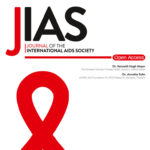The Journal of the International AIDS Society has published a CHAI-led evaluation of point-of-care early infant diagnosis (POC EID) of HIV in six African countries. The study found that same-day test results dramatically improved infants’ initiation onto life-saving HIV treatment.
Despite significant scale-up of programs to prevent mother-to-child transmission of HIV, over 400 children globally are infected with HIV every day [1]. If left untreated, up to 30 percent of infected children will die by their first birthday and 50 percent by their second [2].
The disease progresses more quickly in infants. For infants not on treatment, peak mortality occurs between 2 and 3 months old.
That is why testing infants early is so important. The World Health Organization recommends that all HIV-exposed infants be tested within four to six weeks of birth and that results are returned to their caregivers as soon as possible.
While access to EID testing for HIV-exposed infants using centralized platforms has improved in the last decade, it continues to lag behind need: coverage has increased from 28 percent in 2011 [3] to 60 percent in 2019 [4]. In addition, lack of quick access to the test results limits the clinical utility of the results.
Testing on centralized platforms has resulted in long turnaround times, poor result return, and low treatment rates for infants. Multiple factors are responsible, including lengthy transport times to laboratories for processing and delays in test results being returned due to poor communication back to health facilities and caregivers. These factors can lead to loss-to-follow-up or delayed initiation on life-saving treatment.
POC testing for EID has the potential to dramatically improve the time it takes to determine HIV status and reduce HIV-related morbidity and mortality in infants. POC devices allow for rapid on-site sample processing and testing and can produce test results within hours of sample collection instead of days, weeks, or months. But the real-world impact of scaled up POC EID implementation remained unclear.
The aim of this pre-/post-evaluation in 52 facilities across Cameroon, Democratic Republic of Congo, Ethiopia, Kenya, Senegal, and Zimbabwe, was to assess the clinical impact of POC EID in comparison to centralized laboratory testing, within national programs.
The results were transformational.
This study found that with POC testing, 72 percent of caregivers received infant test results on the same day as sample collection. In addition, HIV-positive infants who received their test results on the same day were six times more likely to start treatment than those who were diagnosed one or more days later.
These findings indicate that POC EID testing is not only feasible but will likely translate to dramatic improvements in survival for HIV-positive infants.
This study complements the recently published CHAI-led evaluation on near-POC HIV viral load in the same journal. Both publications contributed to recently published clinical guidelines from the World Health Organization [5]. The guidelines for EID now strongly recommend that “point-of-care nucleic acid testing should be used to diagnose HIV among infants and children younger than 18 months of age.” These guidelines mark a turning point that enables universal test and treat for infants and other vulnerable patients.
This work was made possible thanks to support from Unitaid.
Citations
- UNAIDS. Children and HIV: Fact sheet. 2016.
- Bourne DE, Thompson M, Brody LL, et al. Emergence of a peak in early infant mortality due to HIV/AIDS in South Africa. AIDS. 2009;23(1):101-6.
- WHO and UNICEF. Global HIV/AIDS Response. Epidemic update and health sector progress toward Universal Access: Progress Report 2011. Geneva: World Health Organization; 2011.
- UNAIDS AIDSinfo 2019 data [Early Infant Diagnosis – Global]. Available from:http://aidsinfo.unaids.org/
- WHO.Updated Recommendations on HIV Prevention, Infant Diagnosis, Antiretroviral Initiation and Monitoring. Geneva: March 2021.






